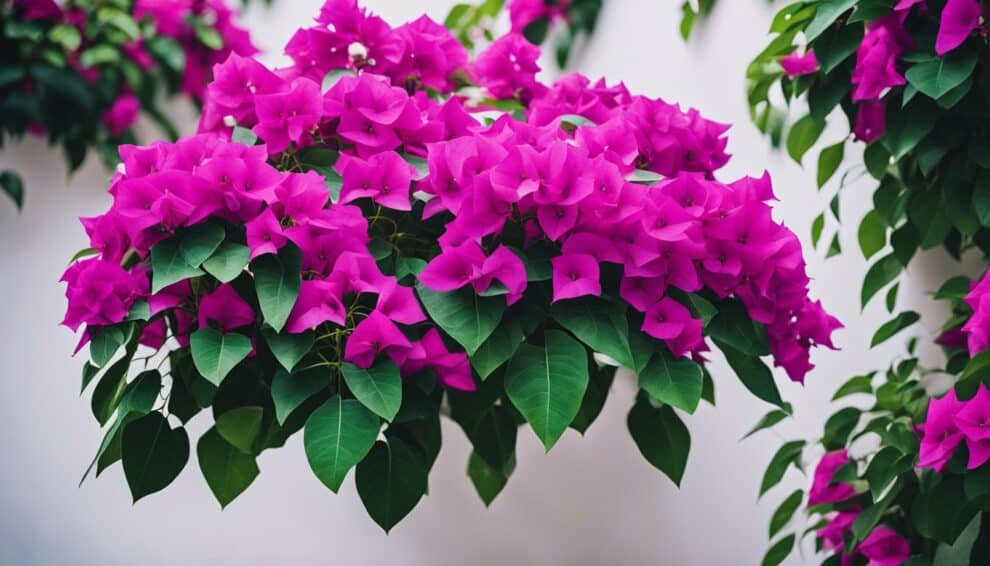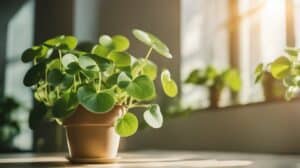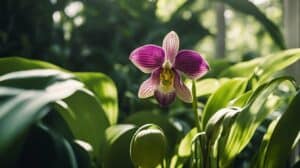Bougainvillea spectabilis is a tropical plant that is known for its vibrant and showy blossoms.
This plant is native to South America, and it has become a popular addition to gardens and landscapes around the world.
Bougainvillea is a hardy plant that can thrive in a variety of conditions, and it is relatively easy to care for.

One of the secrets to getting vibrant blossoms on a bougainvillea plant is to ensure that it is getting enough sunlight.
These plants require at least 6 hours of direct sunlight each day in order to produce the bright, colorful bracts that they are known for.
Bougainvillea plants that are grown in shady areas or that do not receive enough sunlight may produce fewer blossoms, and the blossoms that do appear may be less vibrant in color.
Another important factor in getting vibrant blossoms on a bougainvillea plant is proper watering.
These plants prefer well-drained soil, and they should be watered deeply but infrequently.
Overwatering can lead to root rot and other problems, while underwatering can cause the plant to become stressed and produce fewer blossoms.
By providing the right amount of water and sunlight, gardeners can help their bougainvillea plants produce stunning, vibrant blossoms that are sure to catch the eye.
Understanding Bougainvillea Spectabilis
Species Overview
Bougainvillea Spectabilis is a tropical plant native to South America.
It is a member of the Nyctaginaceae family and is commonly known as Paper Flower or Bougainvillea.
It is widely cultivated in warm climates worldwide due to its beautiful and vibrant colored flowers.
Bougainvillea Spectabilis is a woody vine that can grow up to 30 feet in height and 20 feet in width.
The plant is characterized by its thorny branches, bright green leaves, and clusters of papery flowers.
Growth Habits
Bougainvillea Spectabilis is a fast-growing plant that requires full sun exposure and well-drained soil.
It can tolerate drought conditions and is often used in xeriscaping.
The plant is hardy in USDA zones 9 to 11 and can be grown as a shrub, hedge, or climbing vine.
Bougainvillea Spectabilis can be propagated through stem cuttings or layering.
The plant requires regular pruning to maintain its shape and promote flowering.
Pruning should be done after the flowering season to avoid cutting off new buds.
Bougainvillea Spectabilis is susceptible to pests and diseases such as aphids, mealybugs, and fungal infections.
Regular monitoring and treatment are necessary to prevent damage to the plant.
In conclusion, Bougainvillea Spectabilis is a beautiful and versatile plant that can add color and vibrancy to any garden or landscape.
Understanding its growth habits and requirements is essential for its successful cultivation.
With proper care and maintenance, Bougainvillea Spectabilis can thrive and produce stunning blooms year after year.
Cultivation Techniques

Soil Requirements
Bougainvillea Spectabilis thrives in well-draining soil with a pH level between 5.5 and 6.5.
The soil should be rich in organic matter and have good aeration to support root growth.
It is recommended to mix sand, perlite, or vermiculite into the soil to improve drainage.
Avoid using heavy clay soils as they can hold too much water and lead to root rot.
Sunlight and Placement
Bougainvillea Spectabilis requires full sunlight to bloom vibrantly.
It is important to place the plant in a location that receives at least 6 hours of direct sunlight per day.
If grown indoors, place the plant near a south or west-facing window to ensure it receives enough sunlight.
Bougainvillea Spectabilis is sensitive to cold temperatures and should be protected from frost.
Watering Practices
Bougainvillea Spectabilis prefers to be kept slightly dry and does not like to sit in water.
Water the plant deeply once a week, allowing the soil to dry out between watering. Overwatering can lead to root rot and other fungal diseases.
During the growing season, fertilize the plant every two weeks with a balanced fertilizer to promote healthy growth and vibrant blossoms.
In summary, growing Bougainvillea Spectabilis requires well-draining soil, full sunlight, and proper watering practices.
By following these cultivation techniques, you can enjoy the vibrant blossoms of this beautiful plant.
Maximizing Flowering Potential

Bougainvillea Spectabilis is known for its vibrant and colorful blossoms.
To ensure that your bougainvillea plant produces the maximum number of flowers, it is important to follow certain strategies for fertilization, pruning, and maintenance.
Fertilization Strategies
Bougainvillea Spectabilis requires a balanced and consistent supply of nutrients to produce healthy and vibrant flowers.
The plant should be fertilized every two weeks during the growing season with a balanced fertilizer that contains equal amounts of nitrogen, phosphorus, and potassium.
It is important not to over-fertilize the plant as this can lead to excessive foliage growth and reduced flowering.
To ensure that the plant is receiving the appropriate amount of nutrients, it is recommended to conduct a soil test to determine the pH level and nutrient deficiencies.
Pruning and Maintenance
Pruning is an essential part of maintaining the health and vibrancy of bougainvillea plants.
Regular pruning encourages new growth and promotes the development of new flower buds.
The best time to prune bougainvillea is during the winter months when the plant is dormant.
During this time, the plant can be pruned back to its desired shape and size.
It is important to use sharp and clean pruning tools to prevent damage to the plant.
In addition to pruning, it is important to maintain the plant by providing adequate water and sunlight.
Bougainvillea requires well-draining soil and should be watered deeply once a week during the growing season.
The plant should also be placed in a location that receives at least six hours of direct sunlight each day.
By following these fertilization, pruning, and maintenance strategies, bougainvillea Spectabilis can produce vibrant and healthy flowers throughout the growing season.
Pest and Disease Management

Bougainvillea Spectabilis is a hardy plant that can withstand harsh conditions, but it is not immune to pests and diseases.
Proper pest and disease management is crucial to ensure that the plant produces vibrant blossoms.
Common Pests
Bougainvillea Spectabilis is susceptible to several pests, including:
- Aphids: These small insects feed on the plant’s sap, causing leaves to curl and turn yellow.
- Mealybugs: These pests appear as white, cottony masses on the plant’s leaves and stems, and they can cause stunted growth and yellowing of leaves.
- Spider mites: These tiny pests feed on the plant’s sap, causing leaves to turn yellow and die.
To control these pests, it is recommended to use insecticidal soap or neem oil.
These products are safe for the plant and the environment and can effectively control pests.
Common Diseases
Bougainvillea Spectabilis is also susceptible to several diseases, including:
- Leaf spot: This fungal disease causes brown spots on the plant’s leaves, which can lead to defoliation.
- Powdery mildew: This fungal disease appears as a white, powdery substance on the plant’s leaves and stems, and it can cause stunted growth and yellowing of leaves.
- Root rot: This disease is caused by overwatering and poor drainage and can cause the plant’s roots to rot.
To prevent these diseases, it is important to provide proper drainage and avoid overwatering.
If the plant does become infected, it is recommended to use a fungicide to control the disease.
By following these pest and disease management tips, Bougainvillea Spectabilis can produce vibrant and healthy blossoms.
Frequently Asked Questions

What type of fertilizer works best for vibrant bougainvillea blossoms?
Bougainvillea plants require a balanced fertilizer with equal amounts of nitrogen, phosphorus, and potassium.
A fertilizer with a ratio of 10-10-10 or 20-20-20 is ideal for promoting healthy growth and vibrant flowers.
It is recommended to use a slow-release fertilizer every three months during the growing season.
Can I enhance the color of my bougainvillea flowers using organic methods?
Yes, you can enhance the color of your bougainvillea flowers using organic methods.
Adding coffee grounds, Epsom salt, or bone meal to the soil can help improve the color of the flowers.
Additionally, spraying a solution of one tablespoon of vinegar and one gallon of water on the leaves can also enhance the color.
How often should I feed my bougainvillea to encourage blooming?
To encourage blooming, it is recommended to feed your bougainvillea plant every four to six weeks during the growing season.
However, be careful not to overfeed the plant as it can lead to excessive growth and fewer flowers.
What are the ideal growing conditions for a flourishing bougainvillea plant?
Bougainvillea plants thrive in warm and sunny locations with well-draining soil. They prefer a slightly acidic soil with a pH between 5.5 and 6.5.
It is also important to provide the plant with adequate water and avoid overwatering.
Are there any special care tips for bougainvillea during its flowering season?
During the flowering season, it is important to prune the plant regularly to promote new growth and encourage more flowers.
Deadheading, or removing spent flowers, can also help prolong the blooming period.
Additionally, providing the plant with a balanced fertilizer can help maintain healthy growth and vibrant flowers.
How can I promote continuous blooming in my bougainvillea throughout the year?
To promote continuous blooming, it is important to provide the plant with adequate sunlight, water, and nutrients.
Regular pruning and deadheading can also help promote new growth and encourage more flowers.
Additionally, avoid exposing the plant to extreme temperatures and protect it from frost during the winter months.














